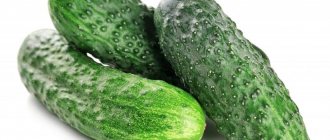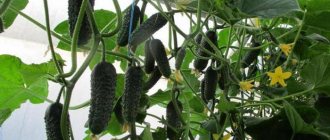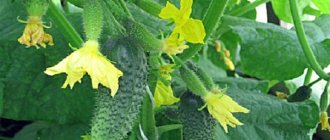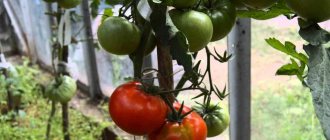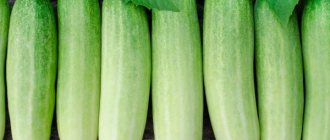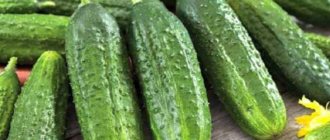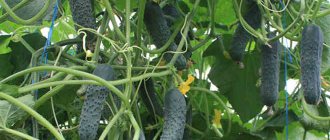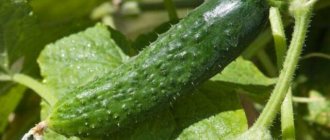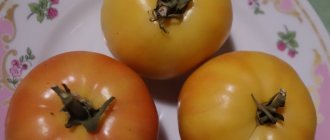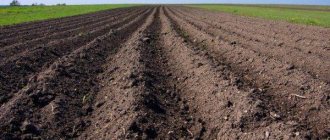Cascade cucumber is a proven variety that has been grown by gardeners from various regions for many years. It grows well in open ground, produces a consistent harvest, and its fruits are tasty and aromatic.
| Landing location | Ripening time | Mode of application | Fruit length | Group | Fruit smoothness | Pollination method |
| Open ground | Early ripening (35-45 days) | Universal | Medium - from 10 to 15 cm | Variety | Highly lumpy | Bee pollinated |
Description of the cucumber variety Cascade
Cucumbers of the Cascade variety were included in the State Register of the Russian Federation in 1982. The hybrid is zoned in the Far East. However, it is successfully grown in other regions. The variety was obtained by breeders of the Far Eastern Research Institute of Agriculture.
The Cascade variety is classified as an early ripening crop. The period from the appearance of sprouts to full harvesting takes 40 - 50 days. Cucumbers are intended for planting in open and closed ground. The method of cultivation directly depends on the weather conditions of the region.
The inflorescences of the plant are female. The leaves are medium in size and green in color. The length of the main shoot reaches 1 - 1.5 m. The bushes are characterized by moderate growth vigor. The flowers of the plant are pollinated by bees.
According to the description and photo, Cascade cucumbers have the following features:
- leveled fruits;
- small bumps on the skin;
- elongated, elliptical shape;
- crispy pulp;
- the length of the greens is 12 - 15 cm;
- weight from 90 to 120 g.
Reviews
Cascade cucumbers have firmly won the love of gardeners: the fruits have absolutely no bitterness, they are resistant to powdery mildew, and thanks to their small size, they are ideal for pickling and canning.
They also note the plant’s low maintenance requirements and high yield. But gardeners focus on the crop’s special preferences for watering: it is important to maintain a fine line here so as not to cause harm.
According to the description, cucumbers can be planted using both seedlings and seed methods. The first option is more often recommended, because... it is a more reliable method. An important condition in caring for a crop at an early stage of growth will be its hardening. Without it, the plant may not take root in open ground.
Agricultural technology for cucumbers Cascade
Cucumber seeds are planted at home in the spring. When warm weather sets in, the plants are moved to a permanent location. It is important to find the right place for the culture. During the entire growing season of the seedling, the plant is provided with good care.
Planting seedlings
Cucumbers of the Cascade variety are planted as seedlings or immediately in a permanent place. The first method is practiced in colder regions. When using seedlings, fruiting of cucumbers begins 2 weeks earlier.
Work begins in April. The material remains viable for 8 - 10 years. At the same time, the greatest yield is obtained from seeds collected 3 - 4 years ago.
First, high-quality specimens are selected for planting and kept warm for a month. Then they are dipped for 20 minutes in a solution of potassium permanganate or the drug Fitosporin.
Advice! Cascade cucumbers are planted in separate containers or peat tablets. This will help skip the picking stage, which has a bad effect on the growth of seedlings.
For planting, use a ready-made purchased substrate or get it yourself. Cucumbers prefer light, fertile soil. To obtain it, fertile soil, peat, sawdust and humus are mixed in a ratio of 2:1:1:2. Place 1 - 2 seeds in each container and sprinkle with a layer of earth 1 - 2 cm thick.
Cascade cucumber shoots appear at a temperature of 22 - 27 °C. Plantings are kept in a dark and warm place. Containers with sprouts are moved to the windowsill. Seedlings should be kept in good light for 13 - 15 hours.
Cascade cucumber seedlings are watered every week. For feeding, use a solution of Nitroammophoska. For 1 liter of water add 1 tbsp. l. fertilizers Plants are watered at the root. For seedlings of Cascade cucumbers, 1-2 feedings are enough.
4 weeks before planting in the ground, cucumbers are hardened in the fresh air. The containers are moved to the balcony or loggia. Gradually the plants adapt to natural conditions.
Landing in the ground
Cucumbers of the Cascade variety are planted in a permanent place in May or early June, after waiting for the soil to warm up and warm weather to set in. For the crop, choose a sunny area, protected from the wind.
Cascade cucumber beds are prepared in the fall. To plant the crop, choose a site after tomatoes, cabbage, onions, garlic, and herbs. Planting after pumpkins, watermelons, melons and zucchini is not recommended. Cucumbers are returned to their original place after 3 - 4 years.
To transplant Cascade cucumbers, choose a cloudy day or evening. If frosts are imminent, the seedlings are covered with non-woven fabric overnight.
Instructions for planting cucumbers in the ground:
- 40 cm deepenings are made in the garden bed. 30 cm are left between plants and 60 cm between rows.
- A handful of wood ash and compost is poured into each hole, then a layer of earth.
- Cascade cucumbers are carefully removed from the containers, taking care not to damage the earthen lump.
- The plants are transferred to the hole, and the empty areas are covered with soil.
- At the end of the procedure, the cucumbers are well watered.
The first time after planting, cucumbers are shaded from the bright sun by placing a paper cap over the plants. For 10 - 14 days, the Cascade variety is not watered or fed. During this period, seedlings adapt to new conditions.
Watering and fertilizing
Moisture and nutrients affect the yield and development of the crop. Cucumbers are cared for throughout the season. The rates of watering and fertilizing depend on the stage of development of the bushes.
Cucumbers of the Cascade variety are watered according to the following scheme:
- before the buds appear - every week, 4 liters per 1 sq. m;
- during flowering - every 3 days, 9 liters of water;
- during fruiting - weekly 4 - 5 liters.
For irrigation, take warm, settled water. Make sure that moisture does not erode the soil. After watering, the soil is loosened so that the plants better absorb nutrients. In order to retain moisture in the soil longer, mulch with humus or straw.
Cucumbers of the Cascade variety are fed every 2 - 3 weeks. For this purpose, both organic and mineral complexes are used. Before flowering, cucumbers are watered with mullein infusion.
Advice! Cascade cucumbers respond positively to natural fertilizers: wood ash and yeast tincture.
At the beginning of fruiting, they switch to potassium and phosphorus fertilizers. Excess nitrogen promotes the growth of shoots and leaves, which negatively affects the formation of fruits. Add 35 g of superphosphate and potassium salt to 10 liters of water. Fertilizer is poured at the roots of plants.
Formation
Due to the formation, the growth of shoots is limited and a high yield is obtained. When the seedlings have the 3rd or 4th leaf, all ovaries and stepsons are removed along the main shoot. Then the plant will direct all its forces to the development of the root system.
The cucumber whip is formed in the form of an inverted pyramid. In this case, 1-2 ovaries are left on the lower shoots: this way the plant develops better and absorbs nutrients.
Protection from diseases and pests
Cascade cucumbers are resistant to downy mildew and other fungal diseases. Lesions spread with low temperatures and high humidity. To protect against diseases, it is important to regulate watering and ventilate the greenhouse. Disinfecting the greenhouse and treating seeds before sowing also helps to avoid diseases.
Important! The drugs Topaz, Privent, etc. will help fight the harmful fungus. Chemicals are not used if there are 3 weeks or less left before harvesting.
Pests cause significant damage to cucumbers: insects feed on plant juices, inhibit their growth, and transmit various diseases. The most dangerous for the crop are thrips, aphids, whiteflies, and spider mites.
Insecticides Karbofos, Iskra, Fitoverm are used against pests. The products are diluted with water and sprayed onto the planting leaves. For prevention, cucumbers are dusted with tobacco dust or wood ash, which can repel pests. In addition, weeds are removed, which often become a haven for insects.
Growing and care
The bushes require abundant watering, but not excessive. The soil should neither dry out nor remain flooded for a long time. The optimal frequency of watering is once every 3-4 days. In hot weather it is possible more often. It also requires more water during fruit ripening.
The water temperature should be equal to the soil temperature or be 1-2 degrees higher.
The crust that forms on the surface of the earth is regularly pierced carefully so that the roots receive oxygen. The lashes are tied to supports, helping to weave.
Fertilizing is applied 2-3 times per season. It is best to use complex mineral fertilizers that contain phosphorus, potassium and nitrogen. They are alternated with organic solutions - solutions of manure or chicken droppings.
Manure is a source of nitrogen. It is necessary to ensure that the bushes do not receive an overdose of this element, as this can cause them to lose productivity.
New generation hybrids
It is hybrid varieties that can be safely planted in low temperatures and successfully grown indoors. Already at the f1 genetic level, the cucumber is resistant to many diseases and unstable natural factors.
Hybrids, as a rule, have earlier ripening periods and high yields, qualities that are most relevant in the short summer conditions of the west and east of Siberia. In addition, when growing hybrids, you do not have to worry about attracting insects to pollinate the ovaries. Most hybrids are parthenocapy and do not require pollination to form fruit. The best varieties for any type of greenhouse are hybrids.
Unlike varietal plants, hybrid plants exhibit most important economic and commercial characteristics: productivity, uniformity of varietal characteristics in all plants, short growing season. Particularly relevant are resistance to changes in humidity, temperature, and resistance to pathogens of viral and fungal diseases. Therefore, hybrids are ideal for growing in greenhouses.
Miranda F1
The universal early-ripening hybrid is characterized by cold resistance and resistance to major cucumber diseases. Can be cultivated outdoors and in protected ground. Does not require pollination. The plant is tall, well leafy.
Zelentsy are 11-12 cm long, weighing up to 120 g. Productivity is good. Up to 6.5 kg of cucumbers per 1 sq. m. The fruits are oblong green in color, with light specks and white stripes up to the middle of the fruit, with white thorns. Miranda cucumbers are tasty and juicy. Suitable for pickling and pickling.
Agricultural technology is no different from the process of growing most varieties. When the soil warms up to 15 degrees, the seedlings are planted in a permanent place. Most often this is the last ten days of May. Plant no more than 3-4 plants per 1 square. m. A garter or attachment to trellises is required.
Siberian bouquet F1
Early ripening, high-yielding hybrid, does not require pollination and is adapted to the low temperatures of Siberia. It is distinguished by friendly yield of fruits. Can be grown in any type of greenhouse and in open ground, resistant to common diseases. The plant is medium-climbing with unusual ovaries of 3-4 cucumbers, which look like a bouquet.
Cucumbers are up to 10 cm long, elongated in shape, and weighing up to 45-50 g. The hybrid has excellent marketability. Its most significant characteristic is the ability to produce a yield of up to 30 kg per square meter. m. The fruits are uniform in size and shape, have dense pulp, small seeds, do not taste bitter, and are ideal for pickling.
Cucumber Siberian bouquet f1 is quite demanding in terms of care. To obtain the maximum yield, you should follow the watering and fertilizing regimes, and remove ripe greens in a timely manner.
Restina F1
Many seed farms and agricultural companies are developing varieties and hybrids for areas with unfavorable weather. As a result of the work of agricultural breeders, a super early, high-yielding, bee-pollinated hybrid, Restina f1, appeared on the seed market.
The plant has genetic resistance to the main fungal, viral and bacterial diseases of cucumbers. From germination to harvest, only 39-40 days pass. The plant has bouquet ovaries, so it looks unusual. Cucumbers are collected in bunches of 3-5 pieces. They can be grown not only in a greenhouse or in a garden plot.
The variety is planted in boxes or pots on balconies and loggias. The plant looks very impressive. The cucumbers are small, gherkin-type, 5-6 cm long. The surface of the cucumbers is finely tuberous, green with light stripes. The pulp is dense, crispy, suitable for canning and preparing summer and winter salads.
The plant is heat-loving; for areas with cold climates, seedling cultivation is recommended. The crop is planted in a permanent location when the danger of frost has passed.
Important! When growing bee-pollinated varieties and hybrids with a female flower type, it is necessary to plant up to 10-15% of the plants with pollinating varieties that produce male flowers. They are planted in each row every 7-8 plants of the main variety.
Preparing for landing
Before planting in the soil, seeds are sometimes soaked in a solution of potassium permanganate, after which they are washed and germinated.
You can plant seeds (seedlings) in open ground when its temperature reaches 15°C (approximately at the end of May). Before this, it should be slightly hardened to prepare it for more severe conditions. This can be done by gradually lowering the air temperature, followed by a slight increase.
The optimal planting density is 3-4 plants per 1 square meter. m. If seeds are sown directly in the garden bed, they are lowered into the soil no deeper than 1.5-2.5 cm.
Drop off point
The plant requires sunlight
Plants should be planted in places protected from the wind, moist and well-lit. The variety requires sufficient heat and moisture for good development. The fertility of the land must also be taken into account. To increase its aeration and improve plant growth, add some leaves or sawdust to the soil.
Plants of this variety require fairly simple, but regular and comprehensive care. Since the Cascade variety is very demanding on soil moisture, abundant and frequent watering plays a direct role. Water must penetrate deep into the soil, and its lack can cause changes in the shape of the fruit.
- Do not forget about loosening the soil, which increases the access of air into the soil to the roots, and also conducts moisture as deep as possible. A necessary part of care is the removal of weeds from the garden bed, as they can greatly harm the growth and development of plants.
- Fertilizers must be added to the soil regularly. Phosphorus, nitrogen and potassium mixtures are perfect, but don’t forget about organic matter. To feed cucumbers of this variety, fertilizers are best used in combination.
- An optional, but often used part of care is tying the plants to a support. Considering the size of the fruit and good yield, you should choose a strong trellis that can support a lot of fruit.
